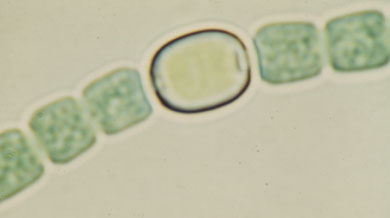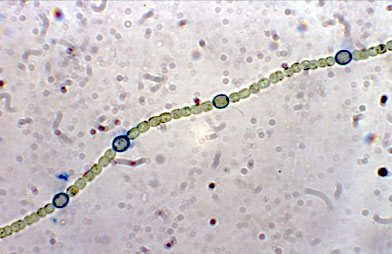Research in S203-S205
Mechanism of heterocyst spacing in cyanobacteria
I. Overview
I.A. Spaced heterocysts: the sites of nitrogen
fixation in filaments of Anabaena
-
Cyanobacteria can do photosynthesis (CO2 to
sugar)
-
Some cyanobacteria can do N2 fixation (N2
to ammonia and ultimately protein)
-
These cyanobacteria can thrive with just water, light,
air, and a bit of salt.
Eat air -- sounds good, why doesn't everyone do it? Part
of the answer is that the processes of photosynthesis and nitrogen fixation
are inherently incompatible: photosynthesis generates oxygen and nitrogen
fixation is poisoned by oxygen.
How does the cyanobacterium Anabaena solve this
problem, both producing O2 by photosynthesis and also fixing
N2? They do so in a most unbacterial way -- growing as multicellular
filaments, consisting of cells linked like beads on a string. There
are two types of cells (Fig. 1):
-
Vegetative cells: Capable of photosynthesis but not
N2 fixation. Most cells are of this type.
-
Heterocysts: Able to fix N2 but not perform
photosynthesis. About one cell in 10 is a heterocyst.

Fig. 1: Heterocyst in filament of Anabaena. Green, photosynthetically
competent vegetative cells surround (and feed) pale heterocyst.
|

Fig. 2: Pattern of spaced heterocysts. Blue cells in this filament
of Anabaena PCC 7120 are heterocysts stained with Alcian blue, a
dye that binds to heterocyst-specific polysaccharide
|
Heterocysts are very expensive to make and to operate,
and so they are not present in Anabaena filaments unless required.
When the cyanobacterium is grown in the presence of a nitrogen source like
ammonia or nitrate, then its filaments have only vegetative cells. However,
if Anabaena finds itself in a medium with no source of nitrogen,
then its filaments look like that shown in Fig. 2.
|
Anabaena grown with nitrogen source
|
Anabaena shifted to medium
without nitrogen source
|
-
Filaments have only vegetative cells
-
No N2-fixation
|
-
Heterocysts appear in 12-18 hours
-
Filaments fix of N2
-
Spacing of heterocysts is not random.
|
Notice that the heterocysts in Fig. 2 are well spaced.
Spacing is certainly a good idea. It
ensures that expensive heterocysts feed as many vegetative cells fixed
nitrogen as possible. But how does Anabaena do it? WE can see the
pattern, looking down from above, but how do THEY -- dumb bacteria -- count?
(To learn more about spacing in Anabaena, click
here)
Consider what we have here! Anabaena, a bacterium,
is capable of:
-
Differentiation, like animal cells
-
Patterns of differentiation, like animals cells
-
Fast differentiation in a test tube, in response to
an easily controlled parameter, most unlike animal cells
Top that off with lots of genetic tools, and
Anabaena
provides an easily manipulated system in which to study patterned differentiation.
